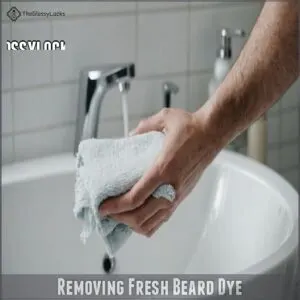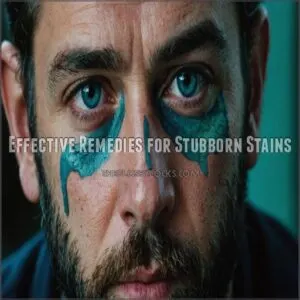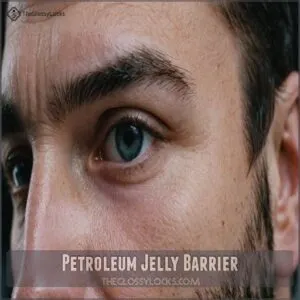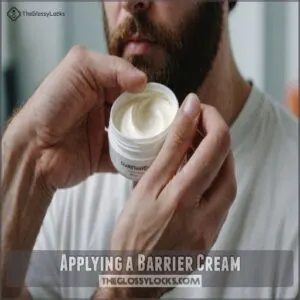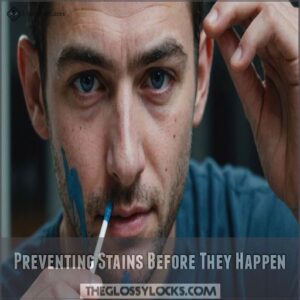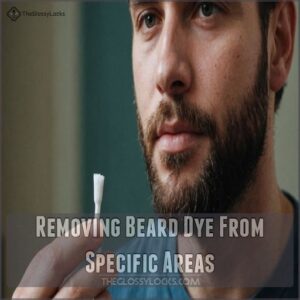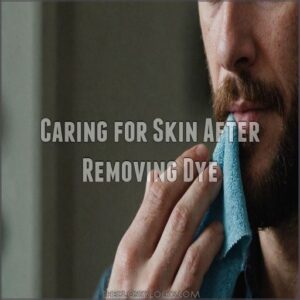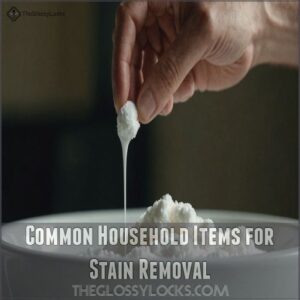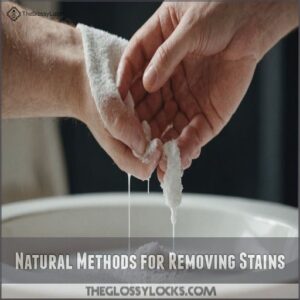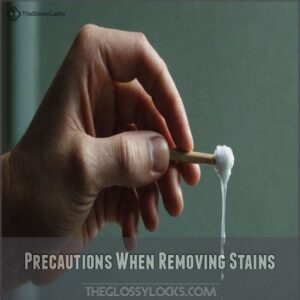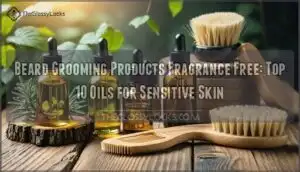This site is supported by our readers. We may earn a commission, at no cost to you, if you purchase through links.
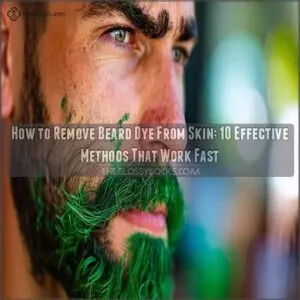 Did your beard dye adventure leave you looking like a patchy panda? Don’t worry, we’ve all been there.
Did your beard dye adventure leave you looking like a patchy panda? Don’t worry, we’ve all been there.
To remove beard dye from your skin, start with a simple soap and water scrub.
If that doesn’t cut it, try a gentle exfoliating scrub or dab some olive oil on the stained areas.
For stubborn spots, mix baking soda with water to create a paste and gently massage it in.
Remember, patience is key – don’t go overboard and irritate your skin.
If you’re in a pinch, a cotton ball soaked in rubbing alcohol can work wonders.
But that’s just the tip of the iceberg – there are even more clever tricks up our sleeves.
Table Of Contents
- Key Takeaways
- Removing Fresh Beard Dye
- Effective Remedies for Stubborn Stains
- Protective Measures for Skin
- Preventing Stains Before They Happen
- Removing Beard Dye From Specific Areas
- Caring for Skin After Removing Dye
- Common Household Items for Stain Removal
- Natural Methods for Removing Stains
- Precautions When Removing Stains
- Seeking Professional Help for Stains
- Frequently Asked Questions (FAQs)
- How do you remove hair dye from a beard?
- How to remove hair dye from skin?
- How do you remove hair dye stains from teeth?
- How do I remove hair dye from my scalp?
- How to remove hair dye from forehead & hairline?
- Can hair dye stain your face?
- Can you remove beard dye from skin?
- What is the fastest way to remove hair dye from skin?
- How long does beard dye last on skin?
- How do you get beard dye off your skin without rubbing alcohol?
- How long do beard dye stains typically last?
- Can beard dye stains cause allergic reactions?
- Are there differences in removing permanent vs. semi-permanent dyes?
- Does skin type affect beard dye stain removal?
- Can beard dye stains damage or discolor clothing?
- Conclusion
Key Takeaways
- Act quickly to tackle beard dye stains by dabbing with a damp cloth; speed is crucial to prevent setting.
- Use household items like olive oil or toothpaste for gentle and effective stain removal options.
- Exfoliation with baking soda paste can remove stubborn stains, but be gentle to avoid skin irritation.
- Protect your skin by applying barrier creams or petroleum jelly before dyeing to prevent stains.
Removing Fresh Beard Dye
You’ve got beard dye on your skin – don’t panic, it happens to the best of us.
Let’s tackle those fresh stains before they set in and turn you into a walking art project.
Immediate Action for Spills
Beard dye spilled? Don’t panic, quick action is your best friend.
Grab a damp cloth or paper towel and wipe that rebellious dye off pronto.
Here’s your game plan:
- Dab, don’t rub – you’re not polishing a trophy
- Work from the outside in to avoid spreading the stain
- Keep at it until your skin looks less like a Jackson Pollock painting
Remember, speed is key. The faster you act, the easier it’ll be to kick that stubborn stain to the curb.
Soap and Water Method
With a splash of warm water, you’re ready to tackle those pesky beard dye stains.
Lather up your hands with a gentle soap and get to work.
Massage the soapy mixture onto the stained areas using circular motions.
For particularly stubborn stains, try using a hair dye removal method like rubbing toothpaste with baking soda to help lift the dye.
Don’t go overboard – gentle scrubbing is key to avoid skin irritation.
Rinse thoroughly with warm water and pat dry.
Repeat if needed, but remember: patience is key when it comes to skin care.
Exfoliation Scrub Technique
Soap not cutting it? Time to up your game with an exfoliation scrub.
Grab a store-bought scrub or whip up a DIY mix using sugar and olive oil.
Gently massage it onto those stubborn dye spots in circular motions.
This beard-saving trick breaks down dye molecules and lifts dead skin cells, giving you a fresh start.
Rinse with lukewarm water and repeat if needed.
Your skin will thank you!
Effective Remedies for Stubborn Stains
Still stuck with beard dye stains?
Don’t worry, you’ve got some handy tricks up your sleeve for those stubborn marks.
From a toothpaste trick that’s gentle on your skin to a powerful baking soda paste for tough stains, we’ll show you how to kick those pesky dye spots to the curb.
Toothpaste Trick for Delicate Skin
Got stubborn beard dye stains on your sensitive skin?
For tougher stains, consider using a toothpaste specifically designed for stain removal, like those found in Stain Removal Products.
Grab a non-gel toothpaste and dab a pea-sized amount on the stained area.
Gently massage it in with your fingertips, like you’re giving your skin a mini-spa treatment.
Let it sit for a few minutes, then rinse with lukewarm water.
Your skin will thank you for this gentle, yet effective DIY remedy!
Baking Soda Paste for Tough Stains
Tackle those stubborn beard dye stains with a DIY baking soda paste.
Mix a tablespoon of baking soda with a splash of water until you’ve got a thick paste.
Gently massage it onto the stained area in circular motions.
Let it sit for 5-10 minutes, then rinse thoroughly.
Repeat if needed.
This natural method harnesses baking soda’s exfoliating power to lift dye from your skin without harsh chemicals.
Lemon Juice and Salt Scrub
Feeling a bit salty about those stubborn beard dye stains? Let’s juice up your removal game with a zesty DIY scrub. This natural alternative packs a punch:
- Mix 1 tablespoon lemon juice with 1 teaspoon salt
- Gently massage the mixture onto stained areas
- Leave on for 2-3 minutes (time for a quick selfie!)
- Rinse thoroughly and pat dry
This citrusy concoction exfoliates while the lemon’s acidity breaks down dye molecules.
Just remember, if you’ve got sensitive skin, go easy – this scrub can be a bit rough and tumble!
Protective Measures for Skin
You don’t have to look like a patchy leopard after dyeing your beard.
With a few simple tricks, you can protect your skin from those pesky dye stains and keep your face looking as smooth as a baby’s bottom.
Petroleum Jelly Barrier
Petroleum jelly is your secret weapon against beard dye stains.
Before you dye, apply a thin layer along your hairline, ears, and neck.
This slippery shield keeps dye from sticking to your skin.
Here’s a quick guide to make your dyeing experience smoother:
| Benefit | Emotion |
|---|---|
| Prevents stains | Relief |
| Easy to apply | Confidence |
| Gentle on skin | Comfort |
| Saves time cleaning up | Satisfaction |
You’ll thank yourself later when you’re not scrubbing away stubborn stains!
Applying a Barrier Cream
Ever wished you’d a magical shield for your skin?
Well, barrier creams are your new best friend!
Slather on some Vaseline, Aquaphor, or coconut oil before dyeing your beard.
These creams create a protective layer, making stains slide right off.
Think of it as your skin’s personal bodyguard.
Apply generously around your beard line and ears.
When you’re done, simply wipe away the cream – and any sneaky dye – with ease.
Wearing Disposable Gloves
While barrier creams offer protection, disposable gloves are your best bet for keeping those hands dye-free.
They’re like a force field for your mitts!
Slip ’em on before you start, and you’ll dodge those pesky stains.
Plus, you’ll avoid turning your fingertips into a Jackson Pollock painting.
For an extra cleansing boost, consider using cotton facial tissues to gently remove any remaining dye residue.
Remember, gloves aren’t just for safety – they’re your ticket to a mess-free beard dyeing experience.
No more scrubbing your hands raw afterward!
Preventing Stains Before They Happen
You don’t have to look like a DIY disaster when dyeing your beard.
With a little prep and the right techniques, you can keep your skin stain-free and rock that fresh beard color without the telltale signs of a home dye job.
Preparing and Protecting Skin
Ready to start dyeing your beard without turning your face into a Jackson Pollock? Let’s set you up for success. Here’s your pre-dye game plan:
- Slather on a barrier cream around your hairline and ears
- Shave any areas you don’t want dyed to reduce staining
- Moisturize your skin to decrease its porosity
- Slip on those disposable gloves – they’re not just for show!
These steps will help you keep the dye where it belongs – on your beard, not your skin.
Using The Right Tools and Techniques
Now that you’ve prepped your skin, let’s talk tools and techniques.
The right gear can make or break your beard dyeing experience.
You’ll want to arm yourself with the proper tools to keep those pesky stains at bay.
For an added safety net, consider investing in a beard dye remover kit to tackle any accidental stains.
Check out this handy table for a quick rundown:
| Tool | Purpose | Pro Tip |
|---|---|---|
| Applicator brush | Even dye distribution | Choose fine bristles for precision |
| Mixing bowl | Proper dye consistency | Opt for non-metallic to avoid reactions |
| Vinyl cape | Protects clothes | Secure it snugly around your neck |
| Gloves | Keeps hands stain-free | Disposable nitrile works best |
| Damp cloths | Quick cleanup | Keep a stack nearby for spills |
Remember, a little prep goes a long way in keeping your skin dye-free!
Following Instructions Carefully
By following instructions carefully, you’ll avoid a beard dye disaster.
It’s not rocket science, but it does require attention to detail.
Stick to the recommended dye application time and mixing ratios for best results.
Here’s why it matters:
- Prevent skin irritation and allergic reactions
- Achieve the desired color without patchy spots
- Minimize the risk of staining your skin
- Boost your confidence with a perfectly dyed beard
Don’t wing it – read those instructions like your beard depends on it!
Removing Beard Dye From Specific Areas
Oops, beard dye mishaps happen to the best of us!
Let’s tackle those tricky spots like your forehead, hairline, and hands with some easy tricks to get your skin back to normal.
Removing Dye From The Forehead and Hairline
Pesky beard dye on your forehead? Don’t sweat it!
Grab a cotton ball soaked in makeup remover and gently dab the stained area.
For stubborn spots, mix equal parts baking soda and water into a paste.
Apply it to your hairline, let it sit for a minute, then rinse.
Remember, prevention’s key – next time, slather on some petroleum jelly along your hairline before dyeing.
It’ll create a barrier and save you the hassle!
Removing Dye From The Scalp
Let’s talk about those sneaky dye stains that creep onto your scalp.
They’re a bit trickier to handle than forehead spots, but don’t worry!
You’ve got options.
Try a gentle scalp exfoliant or mix up a paste of baking soda and water.
Massage it in carefully, then rinse thoroughly.
For stubborn stains, a clarifying shampoo can work wonders.
Remember, patience is key – your scalp’s sensitive, so take it easy and give it time.
Removing Dye From Hands and Skin
Dye on your hands is like a temporary tattoo you never asked for.
No worries, though. Grab some dish soap and baking soda, mix ’em up, and scrub gently.
Still stubborn? Try a dab of olive oil or baby oil to break it down.
For tougher stains, a bit of nail polish remover works wonders.
Remember, patience is key – don’t scrub too hard or you’ll end up with clean, but raw, hands!
Caring for Skin After Removing Dye
You’ve won the battle against beard dye stains, but the war’s not over yet.
Now it’s time to pamper your skin and give it some TLC, because let’s face it, your face deserves a break after all that scrubbing and rubbing.
Hydrating and Soothing The Skin
After scrubbing away those stubborn dye stains, your skin’s feeling a bit raw.
Time to give it some TLC!
Hydrating and soothing your skin post-dye removal is like giving it a comforting hug.
Your face will thank you for the extra care.
Here’s how to pamper your skin:
- Apply a fragrance-free moisturizer to lock in hydration
- Dab on some aloe vera gel for its cooling, soothing properties
- Try a gentle facial oil to nourish and repair
- Use a hydrating face mask for an extra boost of moisture
Gentle Care Routine
Now that you’ve hydrated your skin, it’s time to establish a gentle care routine.
Think of it as pampering your face after a dye-removal battle.
Start with a gentle cleanser for sensitive skin, one that preserves your skin’s natural oils, to wash away any lingering residue.
Follow up with a light, non-comedogenic moisturizer to keep your skin happy.
Don’t forget sunscreen – your freshly treated skin needs extra TLC.
Stick to this routine for a few days, and you’ll be back to your dapper self in no time!
Avoiding Harsh Products
Your skin’s been through the wringer, so let’s keep things gentle.
Ditch those harsh products that’ll only add insult to injury.
Instead, opt for natural alternatives that’ll be kind to your sensitive skin.
Here are some safer options to try:
- Aloe vera gel: Nature’s soothing balm
- Coconut oil: A gentle moisturizer
- Chamomile tea: Calming and anti-inflammatory
These DIY remedies won’t strip your skin’s natural oils or mess with its porosity.
Your beard and skin will thank you!
Common Household Items for Stain Removal
You don’t need to break the bank to tackle those pesky beard dye stains on your skin.
Your kitchen and bathroom cabinets are treasure troves of stain-busting heroes that’ll have you looking dapper in no time.
Using Olive Oil to Remove Dye
Got a beard dye stain? Reach for that bottle of olive oil in your kitchen! This liquid gold isn’t just for cooking – it’s a skin-saver too.
Massage a dab onto the stained area and let it sit for 5-10 minutes. The oil’s natural properties help break down the dye, making it easier to wipe away.
For stubborn stains, try an overnight olive oil treatment. It’s gentle, effective, and leaves your skin feeling silky smooth!
Dish Soap and Baking Soda for Tough Stains
Tackle those stubborn beard dye stains with a powerful duo from your kitchen.
Mix dish soap and baking soda for a DIY stain-busting paste that’ll have your skin looking fresh in no time.
Here’s how to harness this dynamic duo:
- Mix equal parts dish soap and baking soda
- Apply the paste to stained areas
- Gently massage in circular motions
- Rinse thoroughly and pat dry
This natural option packs a punch without harsh chemicals.
You’ll be amazed at how these everyday items can zap those pesky dye marks!
Nail Polish Remover as a Quick Fix
When dish soap and baking soda fall short, reach for nail polish remover.
This acetone-based quick fix can be your secret weapon against stubborn beard dye stains.
Dab a cotton ball with the remover and gently blot the affected area.
Be careful, though – acetone can be harsh on sensitive skin.
After use, rinse thoroughly and moisturize to keep your skin happy.
It’s a powerful DIY solution, but use it sparingly.
Natural Methods for Removing Stains
You don’t need fancy products to tackle beard dye stains – your kitchen’s got you covered!
Let’s explore some natural, wallet-friendly ways to banish those pesky marks using ingredients you probably already have at home.
Using Baking Soda to Lift Dye
How about a kitchen staple to save your skin?
Mix baking soda with water to create a paste.
Apply it to the stained area and let it sit for 5-10 minutes.
Gently massage in circular motions, then rinse thoroughly.
The mild abrasive nature of baking soda helps lift the dye without irritating your skin.
Repeat if needed, but don’t overdo it – your skin will thank you!
Applying Olive Oil for Overnight Treatment
Got stubborn beard dye stains?
Olive oil’s your overnight superhero, also known for its antioxidant properties and moisturizing effects.
Before bed, massage a dollop onto the stained areas.
The oil works its magic, gently breaking down dye while you catch some Z’s.
In the morning, rinse with warm water and mild soap.
Your skin’ll thank you – olive oil’s natural hydration keeps it soft and happy.
Bonus: it’s gentle enough for daily use, so no worries about irritation.
Massaging in Baby Oil to Loosen Stains
Baby oil’s your secret weapon against stubborn beard dye stains.
Like olive oil, it’s gentle yet effective.
Here’s your game plan:
- Squeeze a dime-sized amount onto your fingertips
- Gently massage the oil into stained areas using circular motions
- Let it sit for 15-20 minutes, then wipe off with a warm, damp cloth
This DIY stain removal trick works wonders overnight.
You’ll wake up to softer skin and faded stains.
Talk about beauty sleep!
Precautions When Removing Stains
Regarding removing beard dye stains, you’ll want to play it safe and avoid turning your skin into a science experiment gone wrong.
Let’s walk through some smart precautions that’ll keep your skin happy while you bid those pesky stains farewell.
Avoiding Bleach and Toxic Chemicals
While natural methods are great, let’s talk about what to steer clear of.
You’ll want to avoid harsh chemicals like bleach when tackling beard dye stains.
These can be tough on your skin and might do more harm than good.
Instead, stick to gentler, skin-friendly options.
Here’s a quick rundown of what to use and what to avoid:
| Safe Options | Avoid | Why |
|---|---|---|
| Lemon juice | Bleach | Skin damage |
| Baking soda | Ammonia | Irritation |
| Olive oil | Hydrogen peroxide | Dryness |
Remember, your skin’s health comes first!
Caution With Acetone-Based Removers
Acetone-based removers might seem like a quick fix, but tread carefully!
These tough guys can strip away more than just beard dye.
They’re like sandpaper for your skin, potentially causing irritation or dryness.
Instead, opt for gentler alternatives that’ll treat your skin with kid gloves.
When it comes to removing unwanted hair dye, it’s crucial to consider the potential damage it can cause, such as dryness and breakage, especially for bleached locks using methods like semi permanent dye removal. Remember, your face isn’t a chemistry experiment – stick to safe, skin-friendly methods for beard dye removal.
Your skin will thank you!
Patch Testing Before Removal
Before you go all-in with any stain removal method, play it safe with a patch test.
It’s like dipping your toe in the water before diving in.
Apply a small amount of the product on a discreet spot behind your ear or on your inner arm.
Wait 24 hours to see if your skin throws a fit.
This simple step can save you from a world of itchy, red discomfort.
Seeking Professional Help for Stains
If you’ve tried everything and that beard dye stain just won’t budge, don’t throw in the towel yet.
A hair stylist or color specialist might have some tricks up their sleeve to save your skin (and your pride).
Consulting a Hair Stylist or Color Specialist
Got a stubborn stain that won’t budge?
It’s time to call in the big guns.
If home remedies aren’t working, consider investing in specialized stain removal products to help lift the dye.
These pros have seen it all and have tricks up their sleeves that’ll make those stains disappear like magic.
They’ve got the know-how, the tools, and the expert advice to tackle even the toughest dye disasters.
Don’t sweat it – they’ve got you covered!
Options for Salon Treatment
When home remedies fall short, salon treatments can be a game-changer.
Professional-grade stain removers pack a punch without damaging your skin.
Stylists might use specialized products or techniques to zap those stubborn marks.
While it’ll cost more than DIY methods, you’re paying for expertise and faster results.
Plus, you’ll get pro tips on preventing future stains.
Just remember, treatment duration varies, so ask about post-treatment care to keep your skin happy.
Preparing for Professional Removal
If you’re heading out to seek professional help for those stubborn beard dye stains, here’s how to prep like a pro:
- Snap a few pics of the stained areas for the stylist
- Jot down the dye brand and how long it’s been on your skin
- Before the appointment, consider using a gentle cleansing bar like Dove Beauty Bar Moisturizing Cleanse for removing hair dye to loosen the stain
- Skip harsh scrubbing beforehand to avoid irritation
Remember, pros have tricks up their sleeves and access to salon-grade removers. They’ll tailor the treatment to your skin type, ensuring a gentle yet effective stain removal process.
Frequently Asked Questions (FAQs)
How do you remove hair dye from a beard?
Beard dye slip-up? No worries, buddy. Try a quick wipe with soap and water first.
For stubborn stains, whip up a baking soda paste or use toothpaste.
Gentle exfoliation can work wonders too.
Don’t forget to moisturize after!
How to remove hair dye from skin?
Got dye on your skin? No worries!
Wipe it off immediately with a damp cloth.
For stubborn stains, try soap and water, exfoliation scrubs, or toothpaste.
Remember, quick action’s your best bet.
Need more tips? Just ask!
How do you remove hair dye stains from teeth?
Brush your teeth with baking soda paste to tackle those pesky hair dye stains.
Rinse with hydrogen peroxide for extra whitening power.
Don’t forget to swish with mouthwash after.
Regular dental check-ups help keep your smile bright and stain-free.
How do I remove hair dye from my scalp?
To remove hair dye from your scalp, act fast!
Dab the area with soap and water, then try a paste of baking soda and water.
Gently exfoliate with a scrub or toothpaste.
For stubborn stains, use makeup remover or lemon juice.
How to remove hair dye from forehead & hairline?
Did you know 80% of hair dye mishaps happen at the hairline?
Don’t panic!
Tackle those pesky stains with a dab of petroleum jelly as a barrier next time.
For now, gently exfoliate with a baking soda paste or try the toothpaste trick.
Can hair dye stain your face?
Hair dye’s notorious for its sneaky staining abilities.
It’ll leave its mark on your skin faster than you can say "oops!"
But don’t sweat it – there are tricks to get rid of those pesky stains.
Can you remove beard dye from skin?
Just when you thought you’d be stuck with a stained face, there’s hope!
You can remove beard dye from skin using simple household items.
Try soap and water first, then move on to exfoliation scrubs or toothpaste for stubborn stains.
What is the fastest way to remove hair dye from skin?
Wipe off wet dye immediately with a damp cloth.
For stubborn stains, try a gentle soap or facial cleanser.
Rub in circular motions, then rinse.
If that doesn’t do the trick, exfoliate with a sugar scrub or use non-gel toothpaste.
How long does beard dye last on skin?
Like a stubborn tattoo, beard dye can linger on your skin.
It’ll typically fade within 1-2 weeks, but don’t fret!
With proper care and gentle exfoliation, you’ll see it disappear faster.
Patience is key here, folks.
How do you get beard dye off your skin without rubbing alcohol?
You’ve got options to zap that stubborn beard dye off your skin.
Try a paste of baking soda and water, or use lemon juice with salt for a natural scrub.
Toothpaste can work wonders too.
Remember, gentle circular motions are key!
How long do beard dye stains typically last?
Time’s the ultimate eraser for beard dye stains.
They typically fade within 1-3 days, but can linger up to a week.
Don’t fret – with proper care and cleansing, you’ll see your skin return to normal soon enough.
Can beard dye stains cause allergic reactions?
Beard dye stains can indeed trigger allergic reactions.
Your skin might rebel with redness, itching, or swelling.
It’s like your face throwing a tiny tantrum.
Always do a patch test first to avoid any surprise skin drama.
Are there differences in removing permanent vs. semi-permanent dyes?
Permanent dyes are like superglue for your skin!
They’re tougher to remove than semi-permanent ones.
For permanent stains, you’ll need stronger products and more elbow grease.
Semi-permanent dyes? They’re the easy-going cousins that fade with a few washes.
Does skin type affect beard dye stain removal?
Your skin type does affect dye stain removal, as certain methods may work better on skin that has come into contact with stubborn hair dye stains on walls. Your skin type does affect dye stain removal.
Oily skin may repel stains better, while dry skin might absorb more.
Sensitive skin requires gentler methods.
Tailor your approach to your skin type for the best results.
Can beard dye stains damage or discolor clothing?
Spilling beard dye on clothes can definitely lead to unpleasant stains that are tough to remove and might permanently discolor fabrics.
Act fast, blot the stain, and use a stain remover to tackle it right away.
Conclusion
It just so happens that removing beard dye from your skin isn’t such a legendary struggle after all.
Armed with these 10 tried-and-true methods, you can tackle those pesky stains with confidence.
From simple soap and water to clever tricks like using toothpaste or olive oil, you’ve got plenty of options.
Just remember to keep your skin happy with some TLC afterward.
So go ahead, rock your beard fearlessly, knowing you’ve got the ultimate stain-busting toolkit!
- https://www.researchgate.net/profile/Kirti_Rani2/publication/299975785_Novel_washing_analysis_of_stained_woolen_fabric_having_stains_of_shoe_polish_and_hair_color_dye_with_olive_oil_driven_amylase_loaded_BSANPs_as_bio-active_nano-wool_shampoo_additives/links/570ca3bd08aea660813b2de0.pdf
- https://www.thehennaguys.com/blogs/hair/how-to-get-beard-dye-off-skin
- https://www.healthline.com/health/how-to-get-hair-dye-off-skin
- https://www.verywellhealth.com/how-to-get-hair-dye-off-skin-8407262

